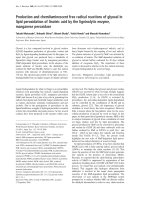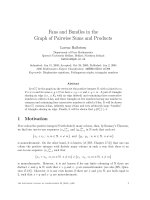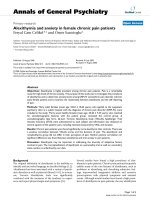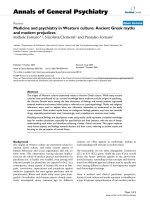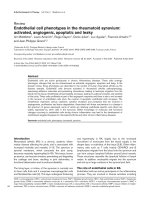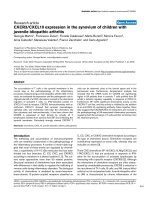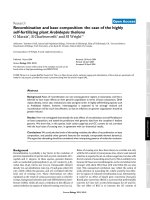Báo cáo y học: "Complexity and integration in the control of inner-ear development" pot
Bạn đang xem bản rút gọn của tài liệu. Xem và tải ngay bản đầy đủ của tài liệu tại đây (48.42 KB, 3 trang )
Genome Biology 2007, 8:315
Meeting report
Complexity and integration in the control of inner-ear
development
Donald L Swiderski*, Tzy-Wen Gong* and Mirna Mustapha
†
Addresses: *Kresge Hearing Research Institute, University of Michigan, Ann Arbor, MI 48109, USA.
†
Human Genetics Department,
University of Michigan, Ann Arbor, MI 48109, USA.
Correspondence: Mirna Mustapha. Email:
Published: 1 October 2007
Genome Biology 2007, 8:315 (doi:10.1186/gb-2007-8-9-315)
The electronic version of this article is the complete one and can be
found online at />© 2007 BioMed Central Ltd
A report on the Sixth Molecular Biology of Hearing and
Deafness Conference, Hinxton, UK, 11-14 July 2007.
A meeting held this summer at the Sanger Centre outside
Cambridge (UK) focused on the molecular biology of hearing
and deafness. Although several proteins are uniquely
expressed in the vertebrate inner ear, these are primarily
found in the sensory hair cells, where they form key compo-
nents of the mechanosensitive stereocilia (the ‘hairs’) of the
organ of Corti in the cochlea. In general, inner-ear
development is guided by the same suites of genes that
control development in other neurogenic tissues, making the
inner ear a good model system for studying the genetic
regulation of development. In this light, we will focus here
on discoveries relating to morphogenesis and cell-fate deter-
mination, the control of gene expression by microRNAs,
identification of deafness-associated genes, and implications
of developmental studies for the remediation of hearing loss.
Inner-ear development
Many studies have looked at the overlapping roles of fibro-
blast growth factors (FGFS) in inner-ear development. The
work on chick presented by Raj Ladher (RIKEN, Kobe,
Japan) was unusual in focusing on the morphogenetic
response of the otic placode to FGF signaling. As might be
predicted from morphogenesis in other tissues, a key
component of the transformation from placode to otic
vesicle is a change in cell shape. Ladher reported that FGF
signaling polarizes the distribution of cytoskeletal proteins
within the placodal cells, and that this polarization underlies
the shape change. The implications of these results extend
beyond otic placode invagination to gastrulation and neuru-
lation, two of the most basic morphogenetic events in
vertebrate development.
Another key event in ear development is the determination
of which cells will become sensory hair cells and which will
become non-sensory supporting cells. A study in chick by
Angelika Dötzlhofer (House Ear Institute, Los Angeles, USA)
showed that this cell-fate determination is somewhat more
complex than just toggling the switch for the ubiquitous
Notch signaling pathway, which is involved in determining
neural cell fate in other situations. In particular, she showed
that cell fates may be dependent on the expression of
Hes/Hey transcription factors, which can be regulated by
both Notch-dependent and independent mechanisms. As a
consequence, sensitivity to disruption of the Notch signaling
pathway may differ between cell types expressing Notch-
independent or Notch-dependent Hes/Hey genes. This
differential responsiveness to Notch signaling might be
important to achieve the complex cytoarchitecture of the
mature organ of Corti.
The most striking demonstration that different cell fates can
result from differential expression of the same few genes was
presented by Matthew Kelley (National Institute on
Deafness and other Communication Disorders, NIH, Bethesda,
USA). In this study, manipulation of FGF signaling in mice
revealed interactions between developing inner hair cells
and the adjacent supporting cells during development. More
remarkable was the demonstration that a separate signal
emanates from the Hensen’s cells of the cochlea, creating a
second signaling gradient in the opposite direction to the
FGF gradient emanating from the developing inner hair
cells. Thus, there are two cues for position relative to the
cochlear axis, which could account for the radial orientation
of stereocilia bundles and differences along the radial
gradient. Previous work by Kelley and colleagues accounted
for the alternation of hair cells and supporting cells in the
auditory epithelium; this new work addresses differentiation
within these cell types and the radial organization and
ordering of subtypes. The new findings could have implica-
tions for hair-cell regeneration. Supporting cells, which often
survive traumas that kill sensory hair cells, may have
encoded positional information and might respond accor-
dingly when stimulated to transdifferentiate into hair cells.
Alternatively, the signaling gradients might be constitutively
expressed and cells are oriented by these signals during
transdifferentiation.
MicroRNA and the inner ear
New at this year’s meeting was a session on microRNAs
(miRNAs), a highly conserved class of small noncoding
RNAs that negatively regulate gene expression by an RNA
interference (RNAi) mechanism. They are produced from
primary RNA transcripts by ribonuclease III family
members Drosha and Dicer. Although miRNAs are known to
influence cellular proliferation and differentiation, little is
known about their function in mammalian inner-ear
development. Several talks examined the links between
miRNA expression, ear development and deafness.
Garret Soukup (Creighton University, Omaha, USA)
addressed the function of RNAi and miRNAs in mouse
inner-ear development using a conditional Dicer knockout.
Preliminary results indicate that disruption of the RNAi
pathway results in severe morphological defects, suggesting
a key role for miRNAs in early inner-ear development.
Donna Fekete (Purdue University, West Lafayette, USA)
discussed the treatment of zebrafish embryos with antisense
morpholino oligonucleotides directed against the miRNAs
miR-96, miR-182 and miR-183, which are expressed in the
lateral line of zebrafish and inner-ear sensory epithelium of
both mouse and zebrafish. Treatment with these
morpholinos both separately and in combination led to
significant reduction in numbers of hair cells in the anterior
and posterior macular epithelium of the embryonic inner ear
without apparent changes in the embryonic stage or size of
the sensory organ. Fekete reported, however, that over-
expression of a double-stranded miR-96 RNA causes an
increase in numbers of posterior macular hair cells and the
precocious appearance of hair cells in the sensory cristae of
the semicircular canals that detect head rotation. She
suggested that the miRNAs may downregulate the
translation of pro-sensory gene transcripts to facilitate the
transition from a pro-sensory state to a hair-cell state.
MicroRNAs can also be linked to known deafness-related
genes. Using bioinformatics and microarray techniques,
Karen Avraham (Tel Aviv University, Tel Aviv, Israel) and her
colleagues screened the mouse genome for predicted miRNA
genes located near deafness-related genes or loci. Assuming
functional conservation during vertebrate evolution, they
also looked for murine homologs of known zebrafish
miRNAs with high levels of expression in the zebrafish ear
and lateral line. Avraham reported that some of the
candidate deafness-related miRNAs thus identified in the
mouse are differentially expressed over time, or are
expressed differently in the cochlea and the vestibular
organs. In addition, they found that some miRNAs not
previously linked to deafness are expressed in the sensory
epithelia of the newborn (postnatal day 0) mouse inner ear.
Mutation analysis reported by several groups at the meeting
also implicates miRNAs as critical regulators of mammalian
hair-cell development. It remains unclear what genes are
regulated by the miRNAs.
Deafness-related genes in humans
In the past 15 years, hundreds of human genes associated
with hereditary deafness have been identified, and comple-
mentary studies in the mouse and zebrafish provide an
avenue for understanding the roles of these genes in ear
development and function. Two new protein-coding genes
implicated in human deafness were described at the
meeting. Fatemeh Alasti (National Institute for Genetic
Engineering and Biotechnology, Tehran, Iran, and
University of Antwerp, Belgium) reported the identification
of a novel homeobox gene responsible for syndromic microtia
(small ear) in an Iranian family. Rob Collin (Radboud
University, Nijmegen, The Netherlands) reported the
identification of mutations in ESRRB (encoding estrogen-
receptor related β protein) by genome-wide analysis of
single-nucleotide polymorphisms (SNPs) in a Turkish family
and subsequently in the original Pakistani DFNB35 family,
both of which have heritable autosomal recessive non-
syndromic deafness. As reported by several groups in the UK
and Australia, mouse N-ethyl-N-nitrosourea (ENU) muta-
genesis screenings are now focused on identification of
mutations in a recessive trait to explore molecules and
models for recessive genes of human deafness.
Most genes known to be associated with human deafness
have been identified in geographically isolated populations
or small families with monogenic mutations. The
elucidation of genes contributing to complex-trait hearing
impairment is in its infancy and is far behind the
investigation of the genetics of other complex diseases.
Gene-environment interactions and ethnicity, age, gender
and exclusion criteria (whether related to other diseases,
asymmetric hearing loss, and so on) are all important
factors to be considered. Lut van Laer (University of
Antwerp, Belgium) reported that studies of SNPs in
candidate genes found that age-related hearing impairment
was associated with SNPs in the gene for the transcription
factor grainyhead-like 2 (GRHL2/DFNA28) in several
populations. In addition to the group’s previous findings of
an association of the genes for a voltage-gated potassium
channel (KCNE1) and a catalase (CAT) with noise-induced
Genome Biology 2007, Volume 8, Issue 9, Article 315 Swiderski et al. 315.2
Genome Biology 2007, 8:315
hearing loss, Annelies Konings (University of Antwerp,
Belgium) reported a new association of hearing loss with
HSP70 (heat shock protein 70) in two populations.
Hair-cell regeneration
All vertebrates have hair cells, but only in mammals are the
hair cells and supporting cells of the auditory epithelium
highly ordered, and only mammals lack the ability to replace
hair cells killed by toxins or loud noise. Several talks
addressed the question of how differences in ear develop-
ment between mammals and other vertebrates may account
for this lack of regenerative ability.
Bernd Fritzsch (Creighton University, Omaha, USA) pointed
out that the decision of cochlear cells to become hair cells is
first indicated by their exiting the cell cycle. He also argued
that Atoh1, a transcription factor that has been the focus of
several hair-cell regeneration studies, is not likely to play a
role in that process because it is not expressed before cell-
cycle exit. He also discussed the need for a comprehensive
model of gene regulation during cochlear development in
order to understand regeneration, highlighting the roles of
three transcription factors known to be important in normal
development of the chicken and mouse inner ear: Prox1
(innervation), Gata3 (cochlear elongation) and Lmx1a
(cochlear histogenesis).
Michael Lovett (Washington University, St. Louis, USA)
presented microarray data from chickens showing that
elements of several signaling pathways known to be impor-
tant during inner-ear development are also activated during
regeneration after deafening, including the Notch, Wnt and
TGFβ pathways. These results will serve a reference studies
for investigations into whether alterations in these pathways
account for the failure of regeneration after deafening in
mature mammals.
After noise or ototoxic chemicals kill hair cells, it is the
supporting cells that must react to the absence of hair cells
by sending and responding appropriately to repair and
regeneration signals. Several presentations discussed factors
influencing the ability of supporting cells to respond to the
signals they receive during repair and regeneration. Nicholas
Daudet (University College London Ear Institute, London,
UK) reported on the activation of the Notch pathway during
hair-cell regeneration in chickens and speculated that it may
preserve a pool of supporting cells for future repopulation of
the depleted auditory epithelium. Jeffrey Corwin (University
of Virginia, Charlottesville, USA) demonstrated that cultures
of chick utricular supporting cells can be perpetuated if they
can be induced to separate from the substrate. They will then
form hollow spheres and become polarized, which is critical
for the subsequent differentiation of hair cells in those
cultures. Azel Zine (University of Montpellier, France)
described how several types of cochlear supporting cells
from the postnatal mouse could be induced to express stem-
cell markers, divide and redifferentiate in culture.
These results all suggest that cochlear supporting cells can
be made receptive to signals for hair-cell development, but
does not explain why they are normally unresponsive.
Yehoash Raphael (University of Michigan, Ann Arbor, USA)
illustrated morphological differences between supporting
cells in deafened guinea pigs exposed to different deafening
agents, and also showed that expression of several cell-
signaling markers varies with both deafening agent and time
since exposure to the agent. These results raise the
intriguing possibility that the receptiveness of supporting
cells to such developmental signals might depend on the
mechanism of deafening and the amount of time after
deafening. The findings may indicate that the failure of
supporting cells to regenerate hair cells in the mammalian
ear has different causes under different circumstances.
Over the past decade we have witnessed a tidal wave of
discovery of hundreds of deafness genes in human families
and mouse models and have gained tremendous
understanding of the roles of these genes in inner-ear
development and function. This meeting signaled a new era
of hearing research, highlighted by recent discoveries in the
contribution of miRNA, polygenic variations and inter-
actions, molecular signaling, and last, but not least,
increasing hope for treatment for hearing loss and deafness.
Acknowledgements
Conference attendance was supported by NIH NIDCD DC001634 to Y.
Raphael (DLS), the Margaret G. Bertsch Research Endowment (TWG),
the Center for Organogenesis University of Michigan, the Deafness
Research Foundation, and the National Organization for Hearing
Research (MM).
Genome Biology 2007, Volume 8, Issue 9, Article 315 Swiderski et al. 315.3
Genome Biology 2007, 8:315

